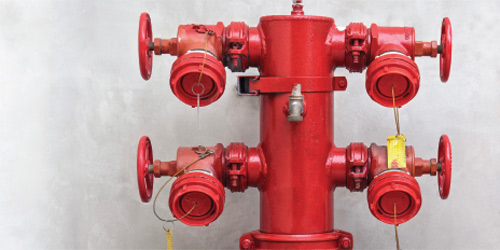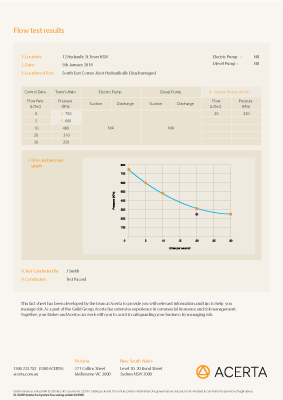
Fire hydrant flow testing
In the event of a fire, responding Fire Brigade Personnel will be heavily reliant on the presence of a dependable supply of water to help them protect your property.
Private Fire Hydrant Systems play a vital role in making water readily available, but systems need to be maintained and tested to ensure reliability.
The Building Code of Australia (BCA) nominates the requirements for the design, installation and maintenance of Private Fire Hydrant Systems. The detailed specifications for these systems are contained in various Australian Standards. The Australian Standard that lists the maintenance requirements for Fire Hydrant Systems is ‘AS 1851:2012 - Routine service of fire protection systems and equipment’. This standard specifies the required frequency for each maintenance task. Typically, these will be;
a. Monthly (for pump related items only)
b. Six-monthly
c. Yearly
d. Five-yearly
Fire Hydrant Systems are required to have general service inspections carried out every 6 months. The date of these inspections will be recorded on a yellow metal tag attached to the hydrant. More detailed testing of the hydrant system’s performance is conducted at yearly and five yearly intervals.
Hydrant Flow testing or, Water Supply Proving Testing, as it is sometimes called, must be conducted at least yearly. When obtaining a yearly Hydrant Flow Test Report from your Fire Systems Maintenance Contractor be sure to check that the correct report has been provided. The following details should be recorded on the test report. In some cases, a water pressure and flow graph may also be provided. An example Hydrant Flow Test Report Is provided on the reverse side of this document.
Details included in a fire hydrant flow test:
- The physical address of the site where the test was conducted.
- The date the test was conducted.
- The location of the tested hydrant/s on your site.
- The hydrant system’s minimum water requirements expressed in terms of flow (l/sec’s) and pressure (kPa).
- The Static Pressure within the hydrant system. This is the water pressure with no hydrants flowing.
- The Residual Pressure. This is the remaining pressure within the hydrant system when one or more hydrants are flowed at a given flow rate.
- Flow and Pressure Graph (optional). This is a graph plotting the various results of the flow test and comparing these results against the system’s minimum flow and pressure requirements.
- The name of the person who performed the test and provided the test report.
- The Conclusion, a statement as to whether the test result passed, or failed to meet the hydrant system’s minimum water requirements.
A failed result could be as simple as a partly closed Stop Valve, but it is better to discover this now rather than during a fire. You should discuss the results of your flow test with your Fire Service Contractor, Insurance Broker or your Insurer.
The numbers above correspond with sections of the sample report on the reverse side of this document.
Download the flow test results here

